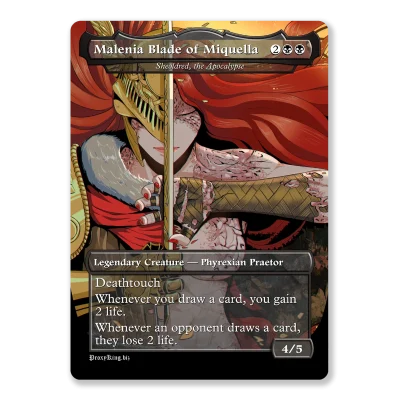Protection in Magic: The Gathering is a keyword ability that offers a specific set of defenses to a card against particular qualities, often summarized by the acronym DEBT. Let’s break down what each letter in DEBT stands for:
- Damage (D): The protected permanent or player cannot be damaged by sources with the specified quality. This means if a creature has Protection from a specific color, it can’t be damaged by creatures or spells of that color.
- Enchant/Equip (E): A permanent with Protection cannot be enchanted or equipped by anything of the specified quality. For instance, a creature with Protection from red can’t be equipped with red artifacts or enchanted by red enchantments.
- Block (B): The creature with Protection can’t be blocked by creatures of the specified quality. This provides a strategic advantage in combat, allowing the creature to attack without being blocked by creatures with the specified characteristics.
- Target (T): Spells and abilities of the specified quality cannot target the permanent or player with Protection. This includes targeted spells or abilities from any source that matches the Protection’s criteria.
Protection can apply to various attributes, such as a specific color (like Protection from red), types of permanents (like Protection from creatures), and even more unique qualities like Protection from specific creature types or mana values. The mechanic is consistent across these different attributes, providing the same DEBT protections irrespective of what the card is protected from.
For example, a creature with Protection from creatures can’t be damaged, blocked, or targeted by other creatures. This makes it effective both in offense and defense. Similarly, a card like Emrakul, the Aeons Torn, which has Protection from colored spells, cannot be targeted or damaged by colored instants and sorceries but can interact with colored equipment and auras under certain conditions.
One of the more intriguing applications of Protection is the “protection from everything” ability, as seen in cards like Progenitus. This form of Protection applies the DEBT rules to all possible attributes, making the creature almost impervious to any form of attack, enchantment, equipment, blocking, or targeting. However, it’s important to note that such Protection doesn’t guard against effects that don’t target or deal damage, such as certain board wipes.
The Evolution of Protection in MTG
Origin in the Alpha and Beta Sets: Protection dates back to the very beginning of MTG, with its debut in the Alpha set. Initially, it was a more straightforward concept, primarily focusing on color protection. Classic examples from these early sets include the Black Knight and White Knight, each embodying the idea of Protection from their respective enemy colors. Additionally, a series of “wards” were introduced as white auras, granting the enchanted creature protection from a specific color.
Evolution Over the Years: The scope of Protection broadened significantly over time. While initially focused on opposing colors, it eventually expanded to include Protection from various attributes, including card types, specific creature types, and even more unique qualities like mana values and specific player actions. This expansion transformed Protection from a straightforward color-based defense into a multifaceted strategy and deck-building tool.
Temporary Phase-Out and Recent Reintroduction: Interestingly, there was a period around 2015 when Wizards of the Coast, the creators of MTG, decided to phase out the Protection Mechanic. This was part of a broader initiative to simplify the game, with Protection being replaced by more straightforward mechanics like “hexproof from X.” However, this change was temporary. Recognizing the unique strategic depth that Protection offered, Wizards of the Coast reintroduced it in newer sets, though its reintegration has been gradual. This reintroduction acknowledges the mechanic’s value in the game’s complex ecosystem.
Different Forms of Protection
The Protection Mechanic in Magic: The Gathering (MTG) encompasses a variety of forms, each catering to different strategic needs and gameplay scenarios. Let’s explore these diverse forms:
Protection from Colors: This is one of the most common forms of Protection. It renders a card immune to damage, enchanting/equipping, blocking, and targeting from anything of the specified color. Classic examples include the White Knight and Black Knight, each having Protection from the opposite color. This form of Protection is particularly effective against decks that heavily rely on a specific color.
Protection from Card Types: Besides color, Protection can be specified against certain card types. For example, Baneslayer Angel has Protection from demons and dragons. This means it can’t be damaged, blocked, enchanted, or targeted by anything that is a demon or dragon, providing a significant advantage in battles against these specific creature types.
Protection from Players and Planeswalkers: This is a unique form of Protection that applies to specific players or sources controlled by them. A notable example is True-Name Nemesis, which allows you to choose a player during its casting, granting it Protection from everything controlled by that player. This makes it an exceptionally powerful card in one-on-one formats.
Protection from Everything: The most comprehensive form of Protection, this type applies the DEBT rule to any card type. Progenitus is a classic example of having “protection from everything.” It can’t be damaged, enchanted, equipped, blocked, or targeted by any source. However, it’s important to note that this doesn’t protect against effects that don’t deal damage or target, such as specific board wipes.
Each form of Protection provides a unique strategic advantage, helping players defend against specific threats or create formidable offensive strategies. Understanding the nuances of these various forms is crucial for maximizing their effectiveness in the game.
Interaction with Other Mechanics
The interaction of the Protection mechanic in Magic: The Gathering (MTG) with other game mechanics is complex and varies depending on the specific mechanics involved:
Protection vs. Trample: Despite common misconceptions, Protection does not prevent trample damage. When a creature with trample attacks, it must assign lethal damage to its blocker(s) and can then assign the remaining damage to the player or planeswalker it’s attacking. If the blocking creature has Protection from the attacking creature’s attributes, the damage to the blocker is prevented, but the trample damage to the player or planeswalker still goes through. For example, if a 5/5 green creature with trample attacks and is blocked by a 1/1 creature with Protection from green, the green creature would assign one damage to the 1/1 creature (which is prevented) and the remaining four damage to the player or planeswalker.
Protection and Double Strike: When a creature with both trample and double strike attacks a creature with Protection, the interaction follows the rules for both abilities. The attacking creature must assign lethal damage in the first and second combat phases. For instance, a 5/5 green creature with trample and double strike attacking a creature with Protection from green would deal one damage (prevented) and four trample damage to the player or planeswalker in both combat phases.
Effect of Protection on Board Wipes: Protection can stop some board wipes but not others. Protection prevents damage from sources it’s protected from and stops creatures from being targeted. So, board wipes that deal damage (like Blasphemous Act) or target creatures won’t affect creatures with Protection from the right attributes. However, Protection does not prevent board wipes that don’t deal damage or target (like Damnation, which destroys all creatures).
Protection and Deathtouch: Protection from a specific attribute also prevents damage from sources with deathtouch of that attribute. Since deathtouch requires the creature to deal at least one point of damage to be lethal, if the damage is prevented (as it is with Protection), the deathtouch effect does not occur.
Strategic Uses of Protection
The strategic uses of the Protection Mechanic in Magic: The Gathering (MTG) vary widely, offering both offensive and defensive advantages across different formats like Commander and Legacy. Here’s an overview of its strategic applications:
Offensive Strategies:
- Evasion in Combat: A creature with Protection from specific colors or types can’t be blocked by creatures with those attributes. This makes it an effective tool for attacking, as it can bypass potential blockers. For instance, a Black Knight with Protection from white can’t be blocked by white creatures, making it a reliable source of damage against decks with white creatures.
- Enabling Unblocked Attacks: Cards like Giver of Runes can grant Protection to a creature, making it unblockable by certain colors or types. A player can use this to ensure their strongest creatures can attack without being blocked, maximizing damage output.
Defensive Strategies:
- Protection from Targeted Removal: Protection can shield creatures from being targeted by spells or abilities of the specified quality. This makes them resilient against common removal spells in the game, enhancing their survivability.
- Blocking Advantages: A creature with Protection can block and effectively neutralize attackers with the specified attribute. For example, a creature with Protection from green can safely block and prevent damage from green attackers.
Using Protection in Different Formats:
- Commander: In multiplayer formats like Commander, Protection can be a powerful tool to safeguard essential creatures from specific threats prevalent in the meta. For example, with its ability to have Protection from a chosen player, True-Name Nemesis becomes a formidable creature in Commander games.
- Legacy: In Legacy, Protection can be used to counter specific metagame threats. Cards with Protection from popular deck colors or types can gain significant advantages.

Common Mistakes and Misconceptions
Common misconceptions and mistakes regarding the Protection mechanic in Magic: The Gathering include:
Misunderstanding Protection’s Scope: A frequent error involves misconceptions about what Protection protects against. Remembering the DEBT acronym – Damage, Enchant/Equip, Block, Target is crucial. For example, a creature with Protection from a specific color can still be affected by non-targeting or non-damaging spells or abilities of that color.
Confusing Protection with Similar Mechanics Like Hexproof: Players often mix Protection with Hexproof. While both offer a form of defense, they function differently. Hexproof prevents a creature from being targeted by spells or abilities your opponents control, but it doesn’t stop damage or blocking as Protection does.
Overestimating Protection’s Abilities in Certain Scenarios: Players sometimes believe that Protection offers a broader range of defense than it actually does. For instance, Protection from a color doesn’t prevent non-damage-based board wipes from affecting the creature. Similarly, while Protection prevents damage from sources it’s protected against, it doesn’t stop trample damage from being assigned and dealt to the player or planeswalker.
Building Decks with Protection in Mind
Building a Magic: The Gathering deck with the Protection mechanic in mind involves strategic planning and understanding how this mechanic interacts with various game scenarios. Here are some tips to incorporate Protection effectively in your deck and balance it with other mechanics:
- Understand the Role of Protection in Your Deck: Determine if Protection is a crucial or supportive strategy. For aggressive decks, Protection can help your creatures avoid blockers or removal. In control decks, it can safeguard key pieces from specific threats.
- Consider the Meta Game: Protection is most effective when tailored against prevalent threats in your playing environment. For instance, if a particular color or creature type is dominant in your meta, including creatures with Protection from those attributes can be highly beneficial.
- Balance Protection with Other Mechanics: While Protection is powerful, it should not overshadow other aspects of your deck. Ensure you have a good mix of creatures, spells, and different abilities to handle various situations.
- Mana Curve and Deck Composition: Pay attention to your deck’s mana curve. Protection cards should fit smoothly into the curve, ensuring a good balance of low, mid, and high-cost cards. Avoid overloading your deck with high-cost Protection cards, as this can slow you down in faster-paced games.
- Synergy with Other Cards: Look for cards that synergize well with your Protection cards. For example, cards that can grant Protection dynamically or those that benefit from creatures with Protection can enhance your overall strategy.
- Testing and Tweaking: Building a deck is an iterative process. Playtest your deck in various scenarios to see how well the Protection elements perform and make adjustments as needed. What works in theory sometimes doesn’t pan out in actual gameplay.
- Sideboard Considerations: Your sideboard should complement the main deck’s strategy against a broader range of decks. Include cards that can add more Protection against specific matchups or answer scenarios where Protection might not be enough.
Remember, the key to a successful deck with Protection is not just about having cards with the ability but how well they integrate and synergize with your overall strategy. As with any MTG deck, flexibility and adaptability to different game situations are crucial for success.
Final Thoughts
The Protection mechanic in MTG offers diverse strategic uses, from creating unblockable attackers to defending against specific threats. Its versatility makes it valuable in offensive and defensive strategies across different game formats.





